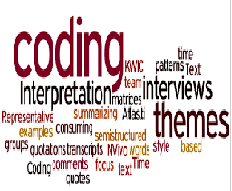Data Analysis for Qualitative Information As is the case with most decisions in public and nonprofit management, there often is not a “right” or “correct” answer.

This is the case with qualitative measurement. Variables may be measured in a variety of ways. Some variables lend themselves to numbers and quantification. Income is a perfect example of this. However, other variables are better measured with words or narrative descriptions. If you want to learn about someone’s experiences participating in a program, you may want to use open-ended questions in an interview or survey to collect this information. This data is qualitative in nature and would be entirely appropriate for your purposes.
For this week’s Discussion, determine what information needs to be measured in a qualitative fashion in your evaluation of the organization’s program, problem, or policy. Review the Learning Resources for this week. Consider what types of qualitative data would be appropriate for your Final Project and the tools and techniques you would use to analyze this information.
Post a description of the qualitative data and the analytical tools and techniques that would be most useful for evaluating your organization’s program, problem, or policy. Justify the use of these tools and techniques, and explain why they are the most appropriate for use in your evaluation.
Required Resources
Data Analysis for Qualitative Information Readings
Johnson, G. (2014). Research methods for public administrators (3rd ed.). Armonk, NY: M. E. Sharpe.
Chapter 11, “Qualitative Data Analysis” (pp. 162–170)
Edin, K., & Pirog, M. A. (2014). A special symposium on qualitative and mixed-methods for policy analysis. Journal of Policy Analysis Management, 33(2), 345–349.
Special Symposium on Qualitative and Mixed-Methods for Policy Analysis by Edin, K., & Pirog, M. A. in Journal of Policy Analysis and Management, 33(2), 345–349. Copyright 2014 by John Wiley & Sons – Journals. Reprinted by permission of John Wiley & Sons – Journals via the Copyright Clearance Center.
Harding, D. J., Wyse, J. J. B., Dobson, C., & Morenoff, J. D. (2014). Making ends meet after prison. Journal of Policy Analysis Management, 33(2), 440–470.
Making Ends Meet After Prison by Harding, D. J., Wyse, J. J. B., Dobson, C., & Morenoff, J. D. in Journal of Policy Analysis and Management, 33(2), 440–470. Copyright 2014 by John Wiley & Sons – Journals. Reprinted by permission of John Wiley & Sons – Journals via the Copyright Clearance Center.
Randles, J. M. (2014). Partnering and parenting in poverty: A qualitative analysis of a relationship skills program for low-income, unmarried families. Journal of Policy Analysis Management, 33(2), 385–412.
Partnering and Parenting in Poverty: A Qualitative Analysis of a Relationship Skills Program for Low-Income, Unmarried Families by Randles, J. M. in Journal of Policy Analysis and Management, 33(2), 385–412. Copyright 2014 by John Wiley & Sons – Journals. Reprinted by permission of John Wiley & Sons – Journals via the Copyright Clearance Center.
Vaterlaus, J., & Higginbotham, B. (2011). Qualitative program evaluation methods. NCSU: Raleigh, NC. Retrieved from http://ncsu.edu/ffci/publications/2011/v16-n1-2011-spring/vaterlaus-higginbotham.php
Optional Resources
Media
Laureate Education (Producer). (2013c). Virtual community. [Multimedia file]. Baltimore, MD: Author.
“Virtual Community” Transcript (PDF)




